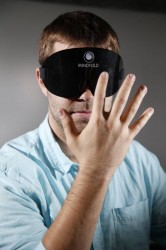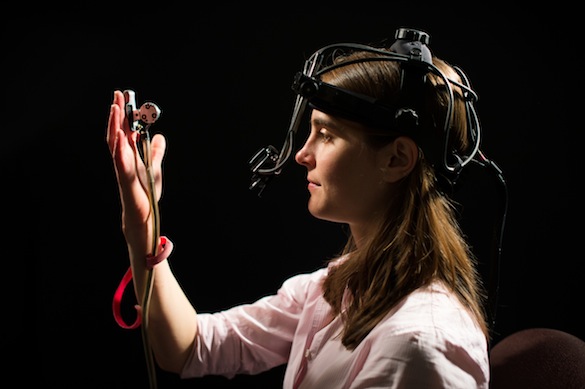On Halloween, the thought of walking through a dark room, hands outstretched to find your way, might take on a more sinister feel than usual, putting you on the lookout for shadowy figures. Yet new research indicates the shadows you see may not be hocus pocus, but your brain perceiving and interpreting your own movements in the dark.
With the help of computerized eye trackers, new research finds that at least 50 percent of people can see the movement of their own hand even in the absence of all light.
“Seeing in total darkness? According to the current understanding of natural vision, that just doesn’t happen,” Duje Tadin, a professor of brain and cognitive sciences at the University of Rochester who led the investigation, said. “[rquote]This research shows that our own movements transmit sensory signals that also can create real visual perceptions in the brain, even in the complete absence of optical input.”[/rquote]
Through five separate experiments testing 129 individuals, the authors found that this curious human ability to see motion provides clues to how the brain processes sensory information.
“Any time you willfully execute a movement—such as waving your hand in front of your face—your brain generates command signals sent to the muscles causing them to produce the movement. Having issued those motor orders, the brain also expects them to be carried out, and that expectation is signaled to other parts of the brain as a heads-up that something is about to happen,” Randolph Blake, Centennial Professor of Psychology at Vanderbilt University and co-author of the study, said. “We surmise that those heads-up signals find their way into the visual pathways, thus producing an illusory impression of what would ordinarily be seen—a kind of self-fulfilling prophecy.”

Tadin, Blake and colleagues at Vanderbilt and Rochester reported their findings online October 30 in Psychological Science, the flagship journal of the Association for Psychological Science.
“This project originated from an entirely accidental discovery Duje and I stumbled upon some years ago. [lquote]We were doing an unrelated study that required the participant to wear a light-tight blindfold, and just for fun I put on the blindfold and waved my hand in front of my face.[/lquote] I was astonished to see that that hand motion remained faintly visible to me,” Blake said. “Duje then tried the same thing and saw the same thing. Being skeptical, we both moved to a completely dark, light-tight room, put on the blindfold and tried it again. Even though our eyes were receiving no light whatsoever we continued to see hand motion. That stunning but puzzling illusion prompted us to launch the project that culminated in this Psychological Science paper.”
The study seems to confirm anecdotal reports that spelunkers in lightless caves often are able to see their hands. In other words, the “spelunker illusion,” as one blogger dubbed it, is likely not an illusion after all.

For most people, this ability to see self-motion in darkness probably is learned, the authors conclude. “We get such reliable exposure to the sight of our own hand moving that our brains learn to predict the expected moving image even without actual visual input,” Vanderbilt postdoctoral researcher Kevin Dieter, said. Dieter was the first author on the paper.
Dieter devised several ways to probe the intriguing observation. In one scenario, the researchers misled subjects by telling them to expect to see motion under low lighting conditions with blindfolds that appeared to have tiny holes in them. In a second setup, the same participants had similar blindfolds without the “holes” and were led to believe they would see nothing. In both setups, the blindfolds were, in fact, equally effective at blocking out all light. A third experiment consisted of the experimenter waving his hand in front of the blindfolded subject. Ultimately, participants were fitted with a computerized eye tracker in total darkness and asked to follow their hand as it passed in front of their face.

In addition to testing typical subjects, the team also recruited people who experience a blending of their senses in daily life. Known as synesthetes, these individuals may, for example, see colors when they hear music or even taste sounds. This study focused on grapheme-color synesthetes, individuals who always see numbers or letters in specific colors.
Across all types of participants, about half detected the motion of their own hand and they did so consistently, despite the expectations created with the faux holes. And very few subjects saw motion when the experimenter waved his hand, underscoring the importance of self-motion in this visual experience. As measured by the eye tracker, subjects who reported seeing motion were also able to smoothly track the motion of their hand in darkness more accurately than those who reported no visual sensation—46 percent versus 20 percent of the time.
Reports of the strength of visual images varied widely among participants, but synesthetes were strikingly better at not just seeing movement, but also experiencing clear visual form. As an extreme example in the eye tracking experiment, one synesthete exhibited near perfect smooth eye movement—95 percent accuracy—as she followed her hand in darkness. In other words, she could track her hand in total darkness as well as if the lights were on.
The link with synesthesia suggests that our human ability to see self-motion is likely based on neural connections between the senses, Tadin said. “[rquote]We know that sensory cross-talk underlies synesthesia. But seeing color with numbers is probably just the tip of the iceberg. Brains are wired for connectivity.”[/rquote]
Blake is an investigator in the Vanderbilt Kennedy Center for Research on Human Development. Paper co-authors also included David Knill and Bo Hu from the University of Rochester.
The study was funded by the following grants: NIH R01-EY019295 (to D.T.), R01-EY017939 (to D.K.), World Class University program through the Korea Science and Engineering Foundation funded by the Ministry of Education, Science and Technology (R31-10089 to R.B.), NIH P30-EY001319, P30-EY009126 and T32-EY007125.